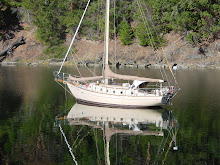Puerto Refugio, BC, Mexico
Hurricane Hilary has come and gone, quietly dissipating way west of the Baja peninsula - turned into a non-event for us here in the Sea of Cortez. There is still a possibility of another storm before the season is over but it is looking pretty good right now - no immediate threats forming down south in the tropical kitchen. By mid-October the hurricane season is essentially over.
Meanwhile, we are still sitting in the west bight of the east bay of Puerto Refugio, which is quickly becoming our favorite place in the Sea of Cortez. The scenery is spectacular, although very desolate. At night the skies are so clear you can pick out individual stars in the Milky way, and during the day it is usually calm and clear as well. Outside of one short-lived wind event a couple of nights ago (no more than 20 knots, from the east), the weather has been picture perfect, although we have seen some pretty frightening lightning off to the east (near the mainland coast) on several evenings - never near enough to hear any thunder.
There are only 3 boats left up here now. Most of the fleet had congregated at Puerto Don Juan for an end-of-the-season party on September 29th. I guess there were about 23 boats there. Now, it seems as if a lot of the cruisers are leaving, or preparing to leave, for points further south. The end of September seems to mark the end of the summer cruising season in the northern sea. As for us, we will probably stick around here for a few more days. The tides here are quite large (up to 13 feet during the new moon) and the resulting currents can be a help or a hindrance when trying to go south in these relatively shallow waters. Also, the winds have been very light and unreliable - what we really want is a steady north wind with an ebbing tide to push us along. Of course, if we do get a north wind, it means we are totally unprotected here in this anchorage (open to the north) and that would add some incentive to our decision to head south.




When we leave here, our intention is to make our way across the sea to San Carlos on the mainland coast, where we hope to be able to park the boat in a marina for a while. We need to get a few things done to the boat (our every expanding list of wants), and we are going to try and find a way to get back to Edmonton for a visit.
Life here in Refugio has been a treat. The snorkeling is the best we have seen so far - interesting reefs with lots of fish. We joined the other boats (4 of us at the time) for our own party and pot-luck on the beach on the 29th of September. We feasted on fresh-caught yellow-tail and grouper and some scallops and mussels harvested on the reef next door. Susanne made a key-lime pie for dessert and we all had a great time. Some kind soul had left an old barbecue on the beach which we used to grill the fish - how great is that?
The weather lately is still quite warm. Our nightly lows get down to about 27 or 28 degrees, while the daytime highs are sill in the low to mid 30s. The water temperature is down a bit to around 27 degrees as well, which actually starts to feel a bit cool after you have been in for an hour or so. Summer is definitely waning.
Today's project will be to try and tackle some of the growth on the bottom of the boat again. Just getting the prop clear of barnacles makes a huge difference to our efficiency when motoring. Then we may go for a short hike on the island - it still gets pretty hot walking in the desert for any length of time.
Before I go, I would like to thank everyone who has sent us emails - it is so nice to get word from home to let us know what we are missing - sorry if we are remiss on timely replies. Most everything we have to say is covered in this blog, making it difficult to come up with any other original news that would be worthy of an email. Basically our life is pretty simple right now and we would like to keep it that way - excitement on a boat usually coincides with heart-pounding anxiety, which we can really do without.
{GMST}29|32.33|N|113|33.4|W|Puerto Refugio, BC, Mexico|Puerto Refugio, BC, Mexico{GEND}





















































